Investigating the potential of Vietnamese tea seed oil (Camellia sinensis O.Kuntze) for the enhancement of oxidative stability in vegetable oils
This study examined the effectiveness of different antioxidative
compounds, namely 0.2% BHA (Butylated hydroxyanisole) + BHT
(butylated hydroxytoluene), 0.03% α – tocopherol, and 3% and 6%
tea seed oil (TSO) on the oxidative stability of vegetable oils. Four
commonly used oils, viz. rapeseed oil (RSO), peanut oil (PNO),
sunflower oil (SFO), and soybean oil (SBO), were assessed by the
Schall Oven test method and monitored during the 12-day
preservation period under 60°C. The total oxidation values
(TOTOX) of the samples treated with 6% TSO were lower than those
treated with 0.2% BHA+BHT. The results indicated the potential of
TSO as a novel natural antioxidant for dietary vegetable oils. Our
study also suggested that TSO could serve as an effective substitution
for currently used synthetic antioxidants such as BHA and BHT.
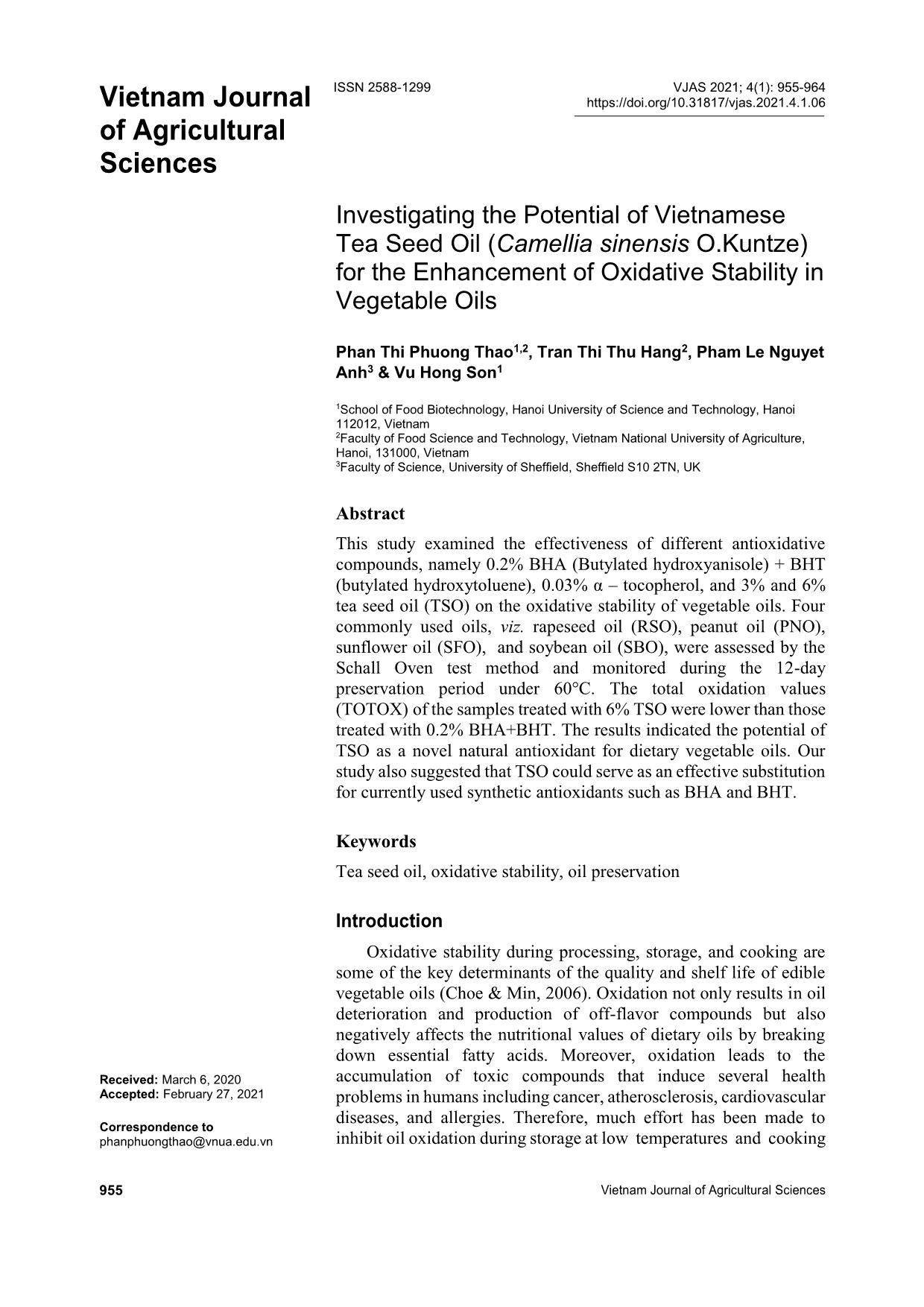
Trang 1
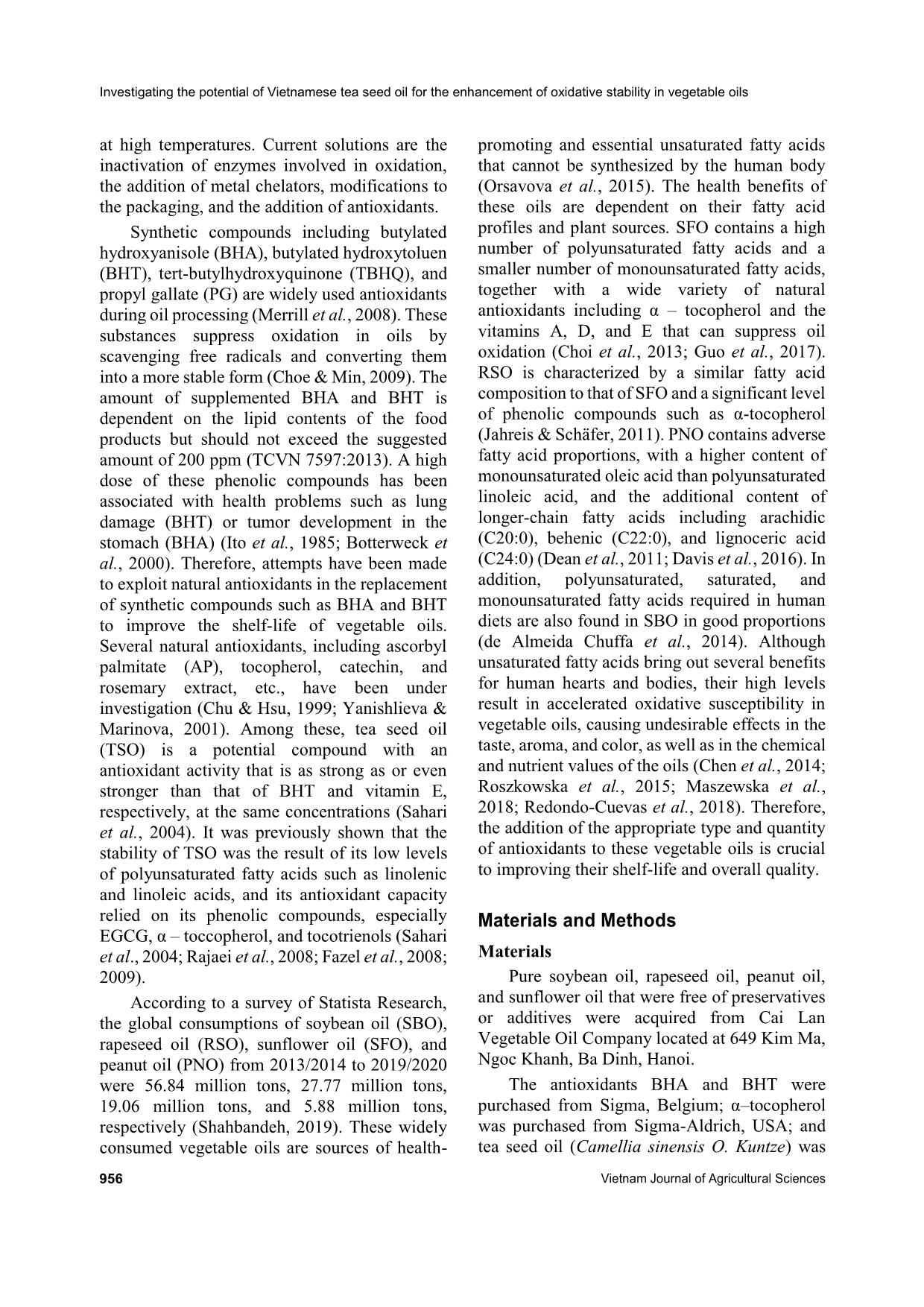
Trang 2
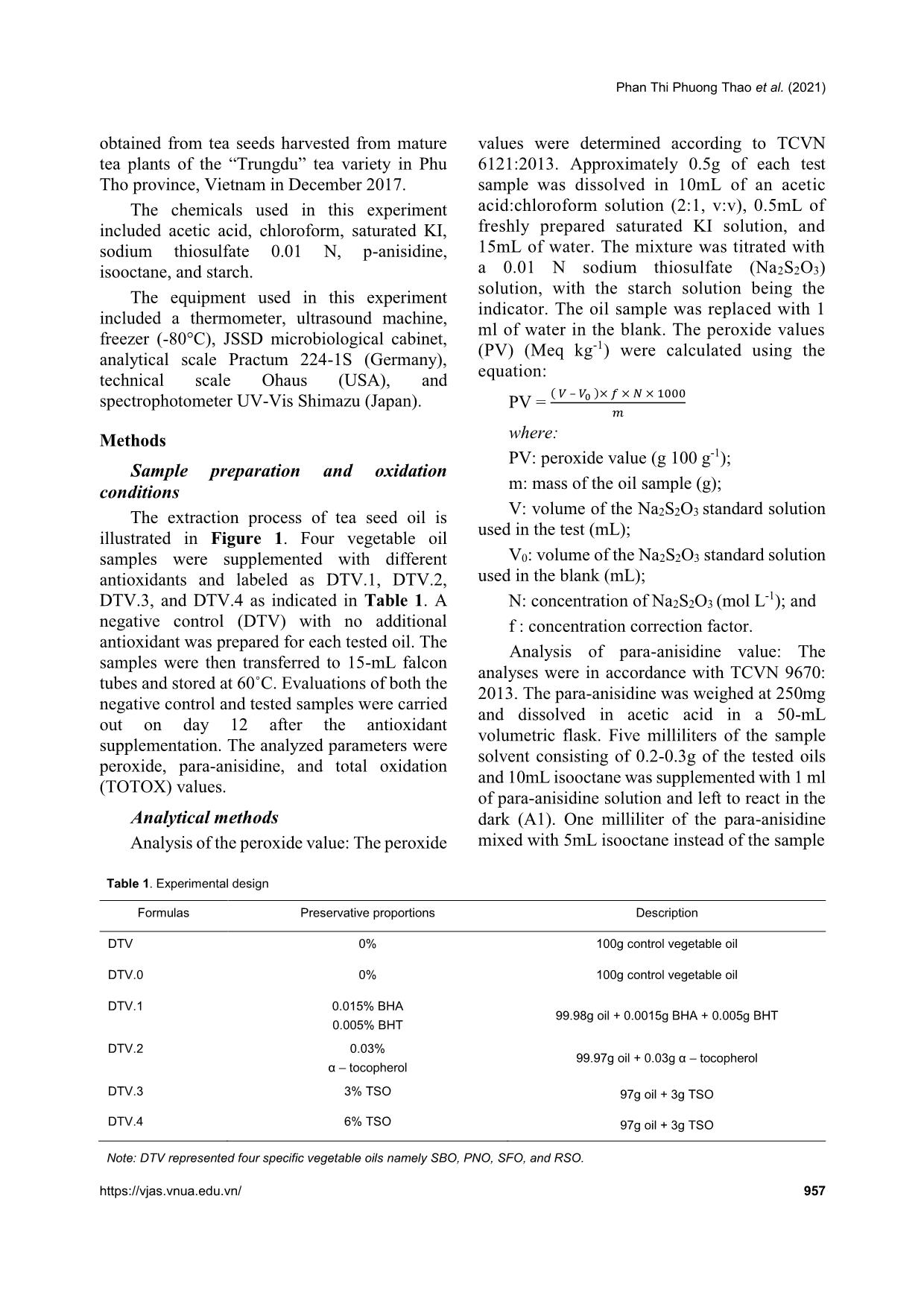
Trang 3

Trang 4

Trang 5
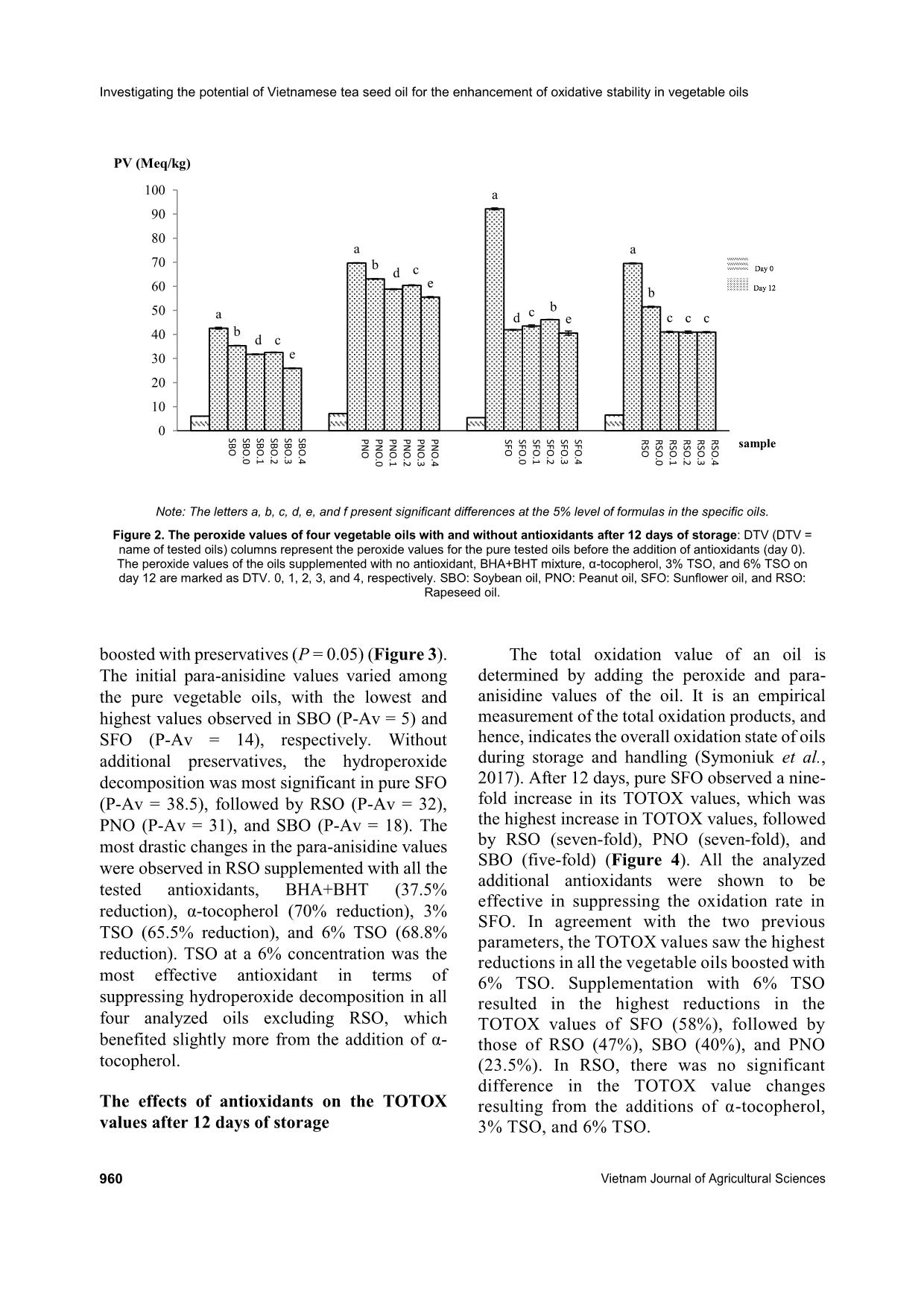
Trang 6
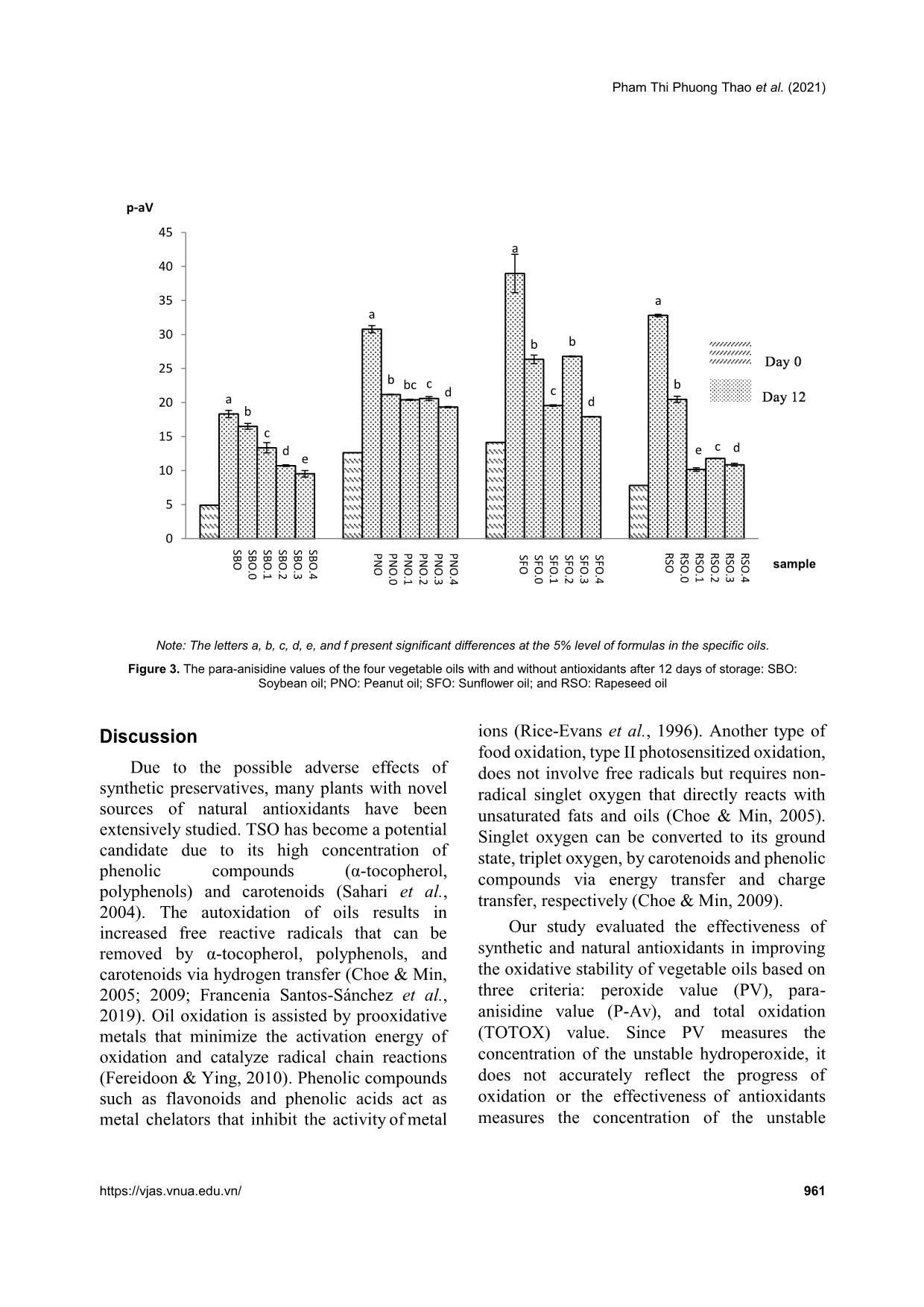
Trang 7
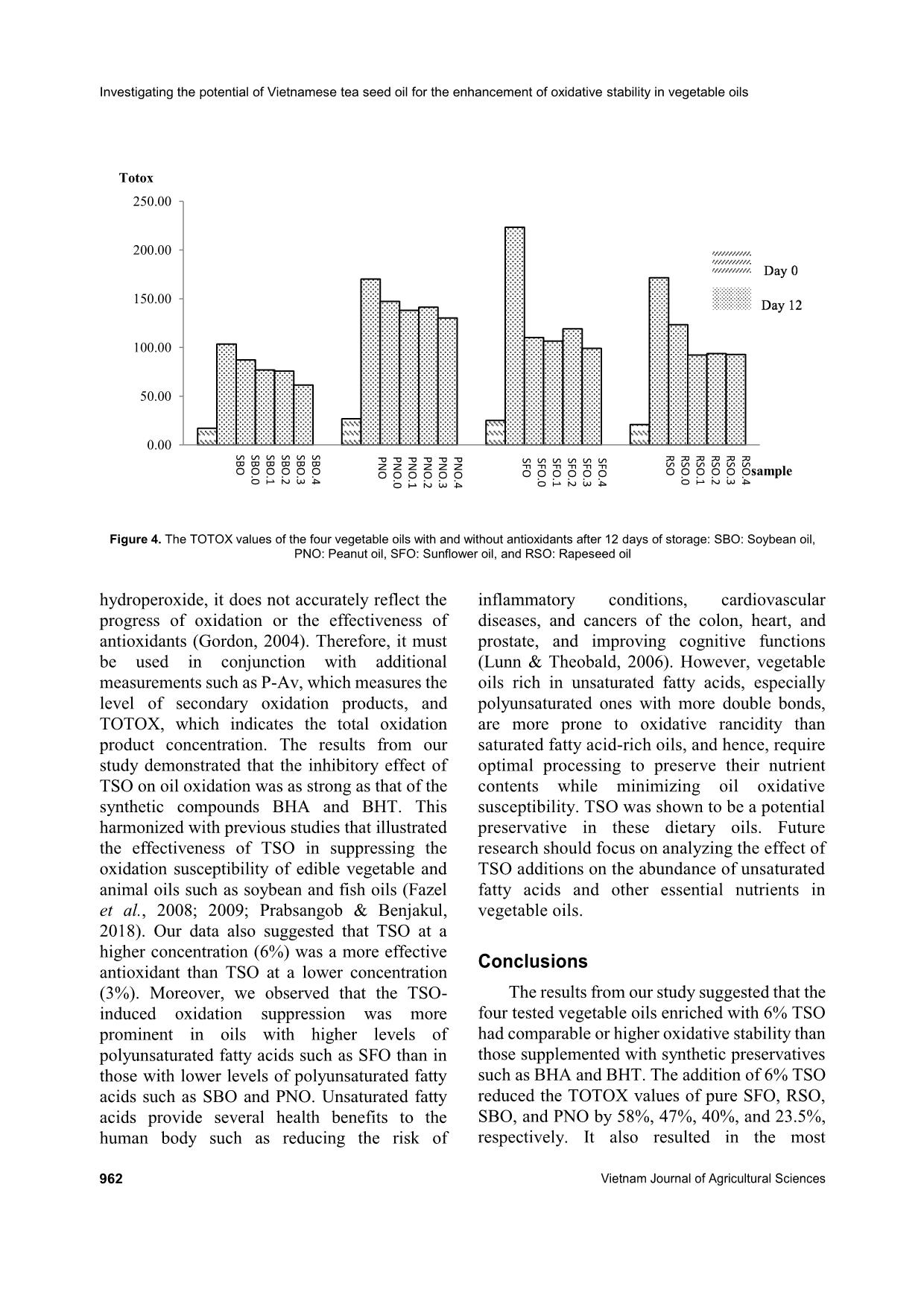
Trang 8
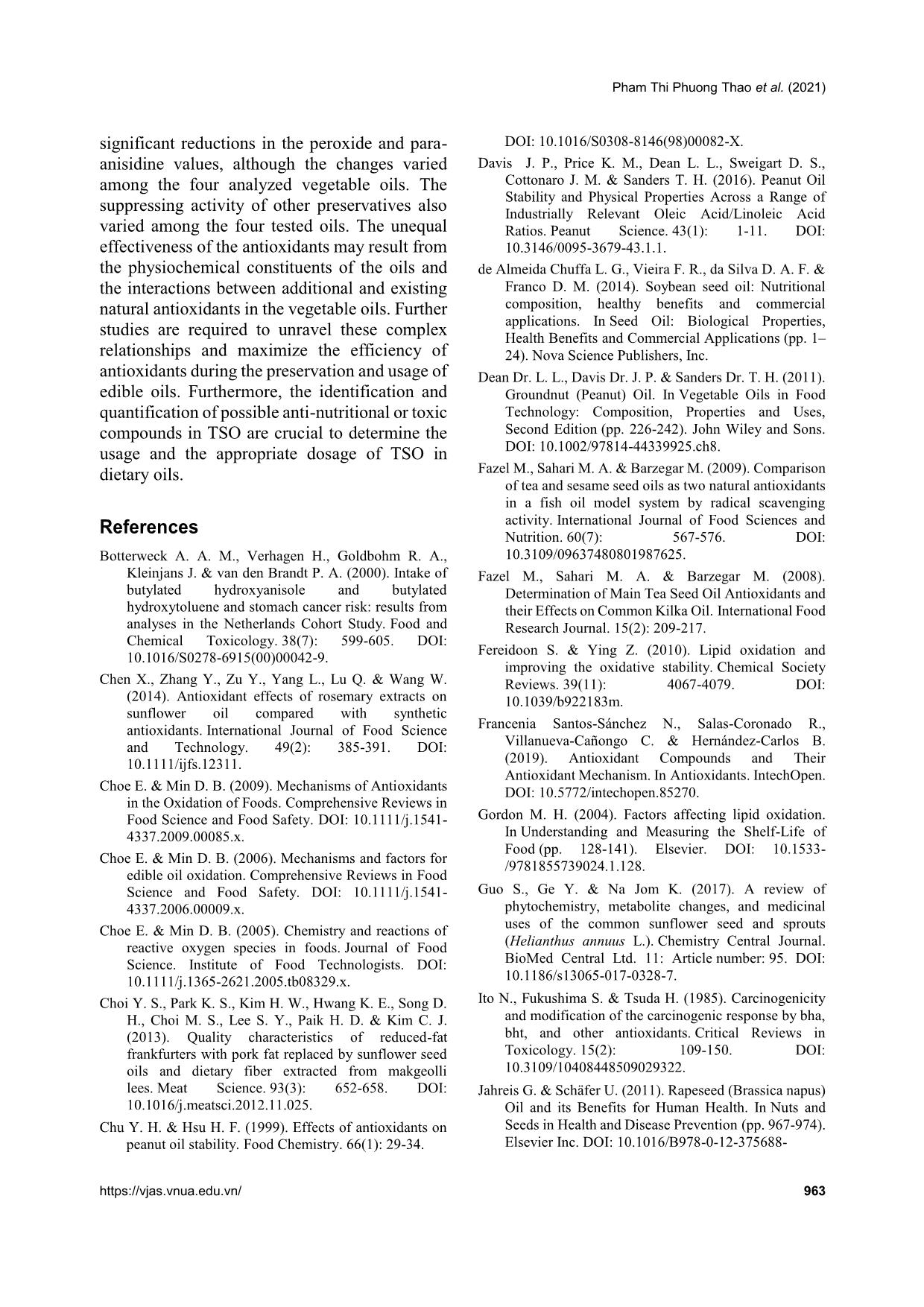
Trang 9
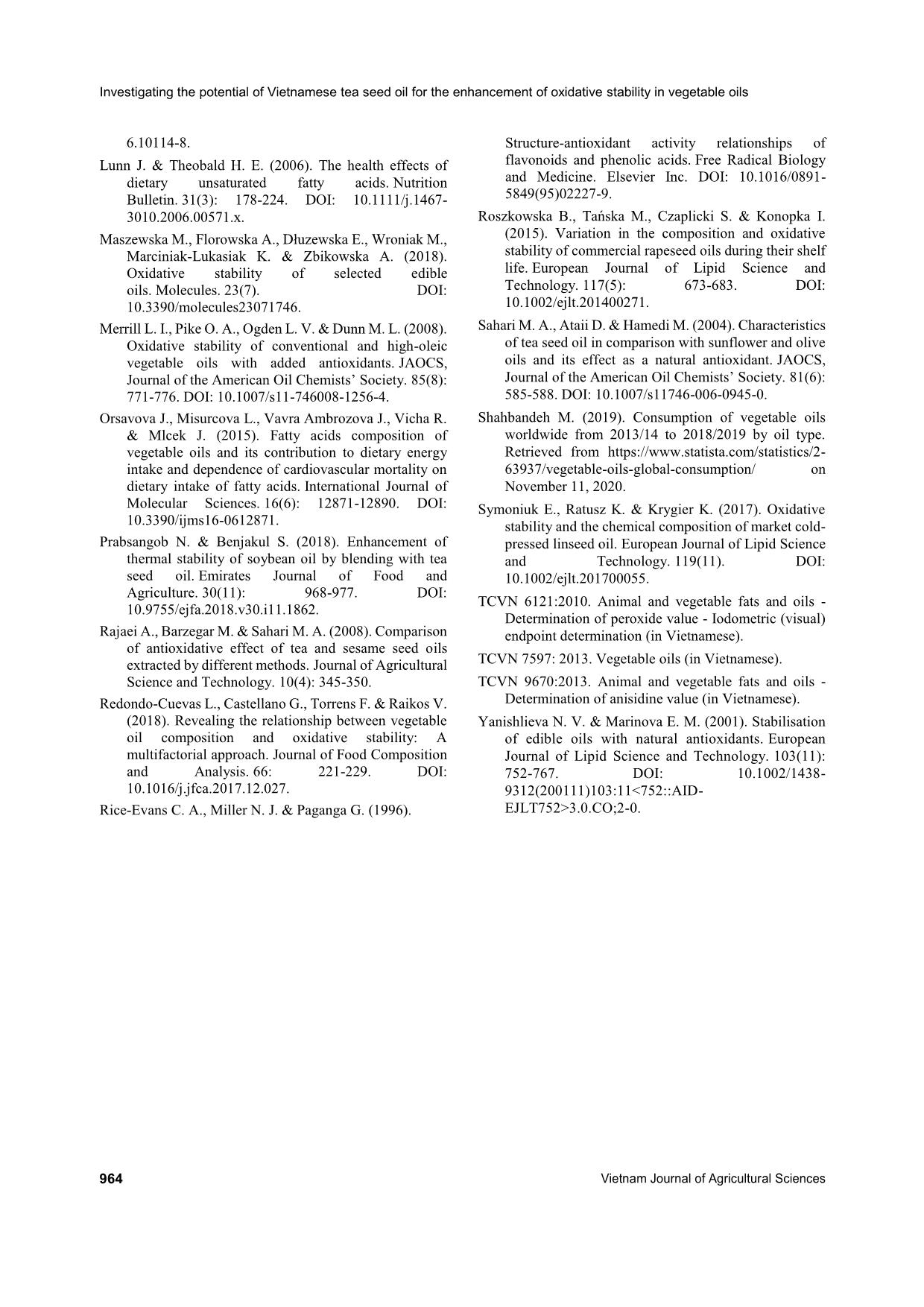
Trang 10
Tóm tắt nội dung tài liệu: Investigating the potential of Vietnamese tea seed oil (Camellia sinensis O.Kuntze) for the enhancement of oxidative stability in vegetable oils
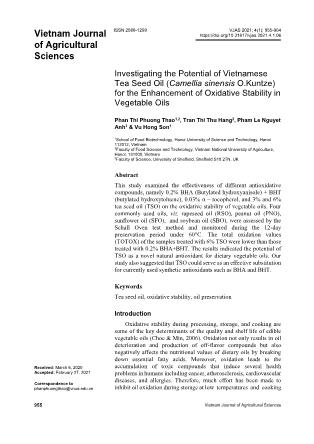
ctions in the TOTOX values of SFO (58%), followed by those of RSO (47%), SBO (40%), and PNO (23.5%). In RSO, there was no significant difference in the TOTOX value changes resulting from the additions of α-tocopherol, 3% TSO, and 6% TSO. a a a a b b b b c c c c d d d c e e e c 0 10 20 30 40 50 60 70 80 90 100 PV (Meq/kg) sample SB O .4 SB O .3 SB O .2 SB O .1 SB O .0 SB O P N O .4 P N O .3 P N O .2 P N O .1 P N O .0 P N O SFO .4 SFO .3 SFO .2 SFO .1 SFO .0 SFO R SO .4 R SO .3 R SO .2 R SO .1 R SO .0 R SO Pham Thi Phuong Thao et al. (2021) https://vjas.vnua.edu.vn/ 961 Note: The letters a, b, c, d, e, and f present significant differences at the 5% level of formulas in the specific oils. Figure 3. The para-anisidine values of the four vegetable oils with and without antioxidants after 12 days of storage: SBO: Soybean oil; PNO: Peanut oil; SFO: Sunflower oil; and RSO: Rapeseed oil Discussion Due to the possible adverse effects of synthetic preservatives, many plants with novel sources of natural antioxidants have been extensively studied. TSO has become a potential candidate due to its high concentration of phenolic compounds (α-tocopherol, polyphenols) and carotenoids (Sahari et al., 2004). The autoxidation of oils results in increased free reactive radicals that can be removed by α-tocopherol, polyphenols, and carotenoids via hydrogen transfer (Choe & Min, 2005; 2009; Francenia Santos-Sánchez et al., 2019). Oil oxidation is assisted by prooxidative metals that minimize the activation energy of oxidation and catalyze radical chain reactions (Fereidoon & Ying, 2010). Phenolic compounds such as flavonoids and phenolic acids act as metal chelators that inhibit the activity of metal ions (Rice-Evans et al., 1996). Another type of food oxidation, type II photosensitized oxidation, does not involve free radicals but requires non- radical singlet oxygen that directly reacts with unsaturated fats and oils (Choe & Min, 2005). Singlet oxygen can be converted to its ground state, triplet oxygen, by carotenoids and phenolic compounds via energy transfer and charge transfer, respectively (Choe & Min, 2009). Our study evaluated the effectiveness of synthetic and natural antioxidants in improving the oxidative stability of vegetable oils based on three criteria: peroxide value (PV), para- anisidine value (P-Av), and total oxidation (TOTOX) value. Since PV measures the concentration of the unstable hydroperoxide, it does not accurately reflect the progress of oxidation or the effectiveness of antioxidants measures the concentration of the unstable a a a a b b b b c bc c cd c b d e d d e 0 5 10 15 20 25 30 35 40 45 p-aV sample SB O .4 SB O .3 SB O .2 SB O .1 SB O .0 SB O P N O .4 P N O .3 P N O .2 P N O .1 P N O .0 P N O SFO .4 SFO .3 SFO .2 SFO .1 SFO .0 SFO R SO .4 R SO .3 R SO .2 R SO .1 R SO .0 R SO Investigating the potential of Vietnamese tea seed oil for the enhancement of oxidative stability in vegetable oils 962 Vietnam Journal of Agricultural Sciences Figure 4. The TOTOX values of the four vegetable oils with and without antioxidants after 12 days of storage: SBO: Soybean oil, PNO: Peanut oil, SFO: Sunflower oil, and RSO: Rapeseed oil hydroperoxide, it does not accurately reflect the progress of oxidation or the effectiveness of antioxidants (Gordon, 2004). Therefore, it must be used in conjunction with additional measurements such as P-Av, which measures the level of secondary oxidation products, and TOTOX, which indicates the total oxidation product concentration. The results from our study demonstrated that the inhibitory effect of TSO on oil oxidation was as strong as that of the synthetic compounds BHA and BHT. This harmonized with previous studies that illustrated the effectiveness of TSO in suppressing the oxidation susceptibility of edible vegetable and animal oils such as soybean and fish oils (Fazel et al., 2008; 2009; Prabsangob & Benjakul, 2018). Our data also suggested that TSO at a higher concentration (6%) was a more effective antioxidant than TSO at a lower concentration (3%). Moreover, we observed that the TSO- induced oxidation suppression was more prominent in oils with higher levels of polyunsaturated fatty acids such as SFO than in those with lower levels of polyunsaturated fatty acids such as SBO and PNO. Unsaturated fatty acids provide several health benefits to the human body such as reducing the risk of inflammatory conditions, cardiovascular diseases, and cancers of the colon, heart, and prostate, and improving cognitive functions (Lunn & Theobald, 2006). However, vegetable oils rich in unsaturated fatty acids, especially polyunsaturated ones with more double bonds, are more prone to oxidative rancidity than saturated fatty acid-rich oils, and hence, require optimal processing to preserve their nutrient contents while minimizing oil oxidative susceptibility. TSO was shown to be a potential preservative in these dietary oils. Future research should focus on analyzing the effect of TSO additions on the abundance of unsaturated fatty acids and other essential nutrients in vegetable oils. Conclusions The results from our study suggested that the four tested vegetable oils enriched with 6% TSO had comparable or higher oxidative stability than those supplemented with synthetic preservatives such as BHA and BHT. The addition of 6% TSO reduced the TOTOX values of pure SFO, RSO, SBO, and PNO by 58%, 47%, 40%, and 23.5%, respectively. It also resulted in the most 0.00 50.00 100.00 150.00 200.00 250.00 Totox sample SB O .4 SB O .3 SB O .2 SB O .1 SB O .0 SB O P N O .4 P N O .3 P N O .2 P N O .1 P N O .0 P N O SFO .4 SFO .3 SFO .2 SFO .1 SFO .0 SFO R SO .4 R SO .3 R SO .2 R SO .1 R SO .0 R SO Pham Thi Phuong Thao et al. (2021) https://vjas.vnua.edu.vn/ 963 significant reductions in the peroxide and para- anisidine values, although the changes varied among the four analyzed vegetable oils. The suppressing activity of other preservatives also varied among the four tested oils. The unequal effectiveness of the antioxidants may result from the physiochemical constituents of the oils and the interactions between additional and existing natural antioxidants in the vegetable oils. Further studies are required to unravel these complex relationships and maximize the efficiency of antioxidants during the preservation and usage of edible oils. Furthermore, the identification and quantification of possible anti-nutritional or toxic compounds in TSO are crucial to determine the usage and the appropriate dosage of TSO in dietary oils. References Botterweck A. A. M., Verhagen H., Goldbohm R. A., Kleinjans J. & van den Brandt P. A. (2000). Intake of butylated hydroxyanisole and butylated hydroxytoluene and stomach cancer risk: results from analyses in the Netherlands Cohort Study. Food and Chemical Toxicology. 38(7): 599-605. DOI: 10.1016/S0278-6915(00)00042-9. Chen X., Zhang Y., Zu Y., Yang L., Lu Q. & Wang W. (2014). Antioxidant effects of rosemary extracts on sunflower oil compared with synthetic antioxidants. International Journal of Food Science and Technology. 49(2): 385-391. DOI: 10.1111/ijfs.12311. Choe E. & Min D. B. (2009). Mechanisms of Antioxidants in the Oxidation of Foods. Comprehensive Reviews in Food Science and Food Safety. DOI: 10.1111/j.1541- 4337.2009.00085.x. Choe E. & Min D. B. (2006). Mechanisms and factors for edible oil oxidation. Comprehensive Reviews in Food Science and Food Safety. DOI: 10.1111/j.1541- 4337.2006.00009.x. Choe E. & Min D. B. (2005). Chemistry and reactions of reactive oxygen species in foods. Journal of Food Science. Institute of Food Technologists. DOI: 10.1111/j.1365-2621.2005.tb08329.x. Choi Y. S., Park K. S., Kim H. W., Hwang K. E., Song D. H., Choi M. S., Lee S. Y., Paik H. D. & Kim C. J. (2013). Quality characteristics of reduced-fat frankfurters with pork fat replaced by sunflower seed oils and dietary fiber extracted from makgeolli lees. Meat Science. 93(3): 652-658. DOI: 10.1016/j.meatsci.2012.11.025. Chu Y. H. & Hsu H. F. (1999). Effects of antioxidants on peanut oil stability. Food Chemistry. 66(1): 29-34. DOI: 10.1016/S0308-8146(98)00082-X. Davis J. P., Price K. M., Dean L. L., Sweigart D. S., Cottonaro J. M. & Sanders T. H. (2016). Peanut Oil Stability and Physical Properties Across a Range of Industrially Relevant Oleic Acid/Linoleic Acid Ratios. Peanut Science. 43(1): 1-11. DOI: 10.3146/0095-3679-43.1.1. de Almeida Chuffa L. G., Vieira F. R., da Silva D. A. F. & Franco D. M. (2014). Soybean seed oil: Nutritional composition, healthy benefits and commercial applications. In Seed Oil: Biological Properties, Health Benefits and Commercial Applications (pp. 1– 24). Nova Science Publishers, Inc. Dean Dr. L. L., Davis Dr. J. P. & Sanders Dr. T. H. (2011). Groundnut (Peanut) Oil. In Vegetable Oils in Food Technology: Composition, Properties and Uses, Second Edition (pp. 226-242). John Wiley and Sons. DOI: 10.1002/97814-44339925.ch8. Fazel M., Sahari M. A. & Barzegar M. (2009). Comparison of tea and sesame seed oils as two natural antioxidants in a fish oil model system by radical scavenging activity. International Journal of Food Sciences and Nutrition. 60(7): 567-576. DOI: 10.3109/09637480801987625. Fazel M., Sahari M. A. & Barzegar M. (2008). Determination of Main Tea Seed Oil Antioxidants and their Effects on Common Kilka Oil. International Food Research Journal. 15(2): 209-217. Fereidoon S. & Ying Z. (2010). Lipid oxidation and improving the oxidative stability. Chemical Society Reviews. 39(11): 4067-4079. DOI: 10.1039/b922183m. Francenia Santos-Sánchez N., Salas-Coronado R., Villanueva-Cañongo C. & Hernández-Carlos B. (2019). Antioxidant Compounds and Their Antioxidant Mechanism. In Antioxidants. IntechOpen. DOI: 10.5772/intechopen.85270. Gordon M. H. (2004). Factors affecting lipid oxidation. In Understanding and Measuring the Shelf-Life of Food (pp. 128-141). Elsevier. DOI: 10.1533- /9781855739024.1.128. Guo S., Ge Y. & Na Jom K. (2017). A review of phytochemistry, metabolite changes, and medicinal uses of the common sunflower seed and sprouts (Helianthus annuus L.). Chemistry Central Journal. BioMed Central Ltd. 11: Article number: 95. DOI: 10.1186/s13065-017-0328-7. Ito N., Fukushima S. & Tsuda H. (1985). Carcinogenicity and modification of the carcinogenic response by bha, bht, and other antioxidants. Critical Reviews in Toxicology. 15(2): 109-150. DOI: 10.3109/10408448509029322. Jahreis G. & Schäfer U. (2011). Rapeseed (Brassica napus) Oil and its Benefits for Human Health. In Nuts and Seeds in Health and Disease Prevention (pp. 967-974). Elsevier Inc. DOI: 10.1016/B978-0-12-375688- Investigating the potential of Vietnamese tea seed oil for the enhancement of oxidative stability in vegetable oils 964 Vietnam Journal of Agricultural Sciences 6.10114-8. Lunn J. & Theobald H. E. (2006). The health effects of dietary unsaturated fatty acids. Nutrition Bulletin. 31(3): 178-224. DOI: 10.1111/j.1467- 3010.2006.00571.x. Maszewska M., Florowska A., Dłuzewska E., Wroniak M., Marciniak-Lukasiak K. & Zbikowska A. (2018). Oxidative stability of selected edible oils. Molecules. 23(7). DOI: 10.3390/molecules23071746. Merrill L. I., Pike O. A., Ogden L. V. & Dunn M. L. (2008). Oxidative stability of conventional and high-oleic vegetable oils with added antioxidants. JAOCS, Journal of the American Oil Chemists’ Society. 85(8): 771-776. DOI: 10.1007/s11-746008-1256-4. Orsavova J., Misurcova L., Vavra Ambrozova J., Vicha R. & Mlcek J. (2015). Fatty acids composition of vegetable oils and its contribution to dietary energy intake and dependence of cardiovascular mortality on dietary intake of fatty acids. International Journal of Molecular Sciences. 16(6): 12871-12890. DOI: 10.3390/ijms16-0612871. Prabsangob N. & Benjakul S. (2018). Enhancement of thermal stability of soybean oil by blending with tea seed oil. Emirates Journal of Food and Agriculture. 30(11): 968-977. DOI: 10.9755/ejfa.2018.v30.i11.1862. Rajaei A., Barzegar M. & Sahari M. A. (2008). Comparison of antioxidative effect of tea and sesame seed oils extracted by different methods. Journal of Agricultural Science and Technology. 10(4): 345-350. Redondo-Cuevas L., Castellano G., Torrens F. & Raikos V. (2018). Revealing the relationship between vegetable oil composition and oxidative stability: A multifactorial approach. Journal of Food Composition and Analysis. 66: 221-229. DOI: 10.1016/j.jfca.2017.12.027. Rice-Evans C. A., Miller N. J. & Paganga G. (1996). Structure-antioxidant activity relationships of flavonoids and phenolic acids. Free Radical Biology and Medicine. Elsevier Inc. DOI: 10.1016/0891- 5849(95)02227-9. Roszkowska B., Tańska M., Czaplicki S. & Konopka I. (2015). Variation in the composition and oxidative stability of commercial rapeseed oils during their shelf life. European Journal of Lipid Science and Technology. 117(5): 673-683. DOI: 10.1002/ejlt.201400271. Sahari M. A., Ataii D. & Hamedi M. (2004). Characteristics of tea seed oil in comparison with sunflower and olive oils and its effect as a natural antioxidant. JAOCS, Journal of the American Oil Chemists’ Society. 81(6): 585-588. DOI: 10.1007/s11746-006-0945-0. Shahbandeh M. (2019). Consumption of vegetable oils worldwide from 2013/14 to 2018/2019 by oil type. Retrieved from https://www.statista.com/statistics/2- 63937/vegetable-oils-global-consumption/ on November 11, 2020. Symoniuk E., Ratusz K. & Krygier K. (2017). Oxidative stability and the chemical composition of market cold- pressed linseed oil. European Journal of Lipid Science and Technology. 119(11). DOI: 10.1002/ejlt.201700055. TCVN 6121:2010. Animal and vegetable fats and oils - Determination of peroxide value - Iodometric (visual) endpoint determination (in Vietnamese). TCVN 7597: 2013. Vegetable oils (in Vietnamese). TCVN 9670:2013. Animal and vegetable fats and oils - Determination of anisidine value (in Vietnamese). Yanishlieva N. V. & Marinova E. M. (2001). Stabilisation of edible oils with natural antioxidants. European Journal of Lipid Science and Technology. 103(11): 752-767. DOI: 10.1002/1438- 9312(200111)103:11<752::AID- EJLT752>3.0.CO;2-0.
File đính kèm:
 investigating_the_potential_of_vietnamese_tea_seed_oil_camel.pdf
investigating_the_potential_of_vietnamese_tea_seed_oil_camel.pdf

